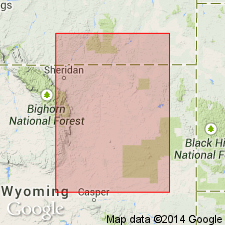
- Usage in publication:
-
- Emigrant Gap Member*
- Modifications:
-
- Original reference
- Dominant lithology:
-
- Sandstone
- Mudstone
- Siltstone
- Shale
- AAPG geologic province:
-
- Green River basin
- Powder River basin
- Wind River basin
Summary:
T7 (fig. 4), T13 (fig. 7), T31-T32. Emigrant Gap Member of Frontier Formation. Consists of (ascending): gray, fine- to medium-grained sandstone, locally conglomeratic, calcareous, and concretionary, up to 60 feet (18 m) thick; medium-gray silty mudstone; gray siltstone; and very fine- to fine-grained sandstone interstratified with lesser amounts of shale, up to 40 feet (12 m) thick. Total thickness up to 140 feet (43 m). Disconformably overlies Belle Fourche Member and disconformably underlies Wall Creek Member, both of Frontier. Age is Late Cretaceous (middle Turonian; COLLIGNOCERAS WOOLIGARI to PRIONOCYCLUS HYATTI zone) based on fossils (mollusks).
Type section: near Emigrant Gap, in NW/4 sec. 4, T. 33 N., R. 81 W., Natrona Co., central WY. Named from the historically significant pass called Emigrant Gap, about 10 mi (16 km) west of Casper, Natrona Co., central WY.
Central Fremont Co., to northwestern Carbon Co., and central Converse Co.; western Johnson Co.
Source: Publication.
For more information, please contact Nancy Stamm, Geologic Names Committee Secretary.
Asterisk (*) indicates published by U.S. Geological Survey authors.
"No current usage" (†) implies that a name has been abandoned or has fallen into disuse. Former usage and, if known, replacement name given in parentheses ( ).
Slash (/) indicates name conflicts with nomenclatural guidelines (CSN, 1933; ACSN, 1961, 1970; NACSN, 1983, 2005, 2021). May be explained within brackets ([ ]).

